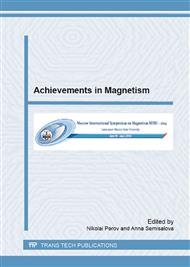[1]
J. M. Williams, et al., Organic Superconductors (including Fullerenes): Synthesis, structure, properties and theory. Englewood Cliffs (New Jersey): Prentise Hall, (1992).
DOI: 10.1002/ange.19941061238
Google Scholar
[2]
T. Ishiguro, K. Yamaji, G. Saito. Organic Superconductors. Springer, (1998).
Google Scholar
[3]
N. Toyota, M. Lang, J. Müller, Low-dimensional Molecular Metals Springer, (2007).
Google Scholar
[4]
R. Shibaeva, E. Yagubskii, Chem. Rev. 104 (2004) 5347.
Google Scholar
[5]
E. B. Yagubskii, I. F. Shchegolev, V. N Laukhin, et al., JETP Letters, 40 (1984) 1201.
Google Scholar
[6]
D. Smith, S. M. De Soto, C. P. Slichter, et al., Phys Rev. B 68 (2003) 024512.
Google Scholar
[7]
T. Enoki, K. Tsujikawa, K. Suzuki, et al., Phys. Rev. B, 50 (1994) 16287.
Google Scholar
[8]
Y. Nakazawa , S. Yamashita, Crystals 2 (2012) 741.
Google Scholar
[9]
B. J. Powell, Ross H. McKenzie, Rep. Prog. Phys. 74 (2011) 056501.
Google Scholar
[10]
S. Elsässer, D. Wu, M. Dressel, J. A. Schlueter Phys. Rev. B 86 (2012) 155150.
Google Scholar
[11]
А.А. Bardin, А.I. Kotov, S.S. Khasanov, et al., Rus. J. Coord. Chem., 32 (2006) 88.
Google Scholar
[12]
A. Lapinski, A.I. Kotov, Chem. Phys., 326 (2006) 551.
Google Scholar
[13]
A. Lapinski, A. Gasecka, A. Graja, et al., Optical Materials, 34 (2012) 1651.
Google Scholar
[14]
A. Chernenkaya, O.V. Koplak, A.I. Kotov et al., Physics of the Solid State 54 (2012) 2391.
Google Scholar
[15]
R. B. Morgunov, A. I. Dmitriev, A. S. Chernenkaya, et al., JETP, 111 (2010) 857.
Google Scholar
[16]
O. Kahn, Molecular Magnetism, VCH. Publishers Inc., New York, (1993).
Google Scholar
[17]
F. Kagawa, K. Miyagawa, K. Kanoda, Nature Phys. 5 (2009) 880.
Google Scholar
[18]
Y. Iwasa, K. Mizuhashi, T. Koda, Y. Tokura, G. Saito, Phys. Rev. B 49 (1993) 3580.
Google Scholar
[19]
K. Miyagawa, K. Kanoda, A. Kawamoto, Chem. Rev. 104 (2004) 5635.
Google Scholar
[20]
S. Diehl, T. Methfessel, J. Müller, et al., preprint available at arXiv: 1410. 5245.
Google Scholar
[21]
S. Yasin et al. Eur. Phys. J. B 79, 383 (2011).
Google Scholar


